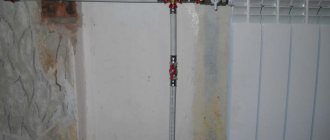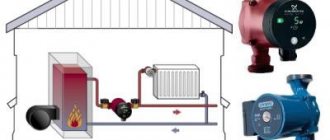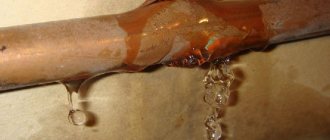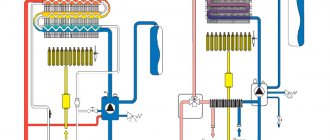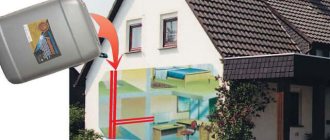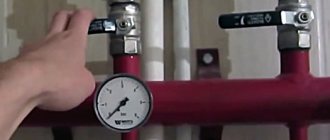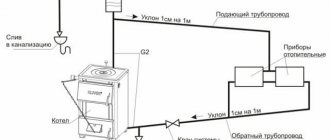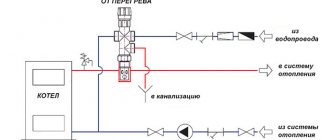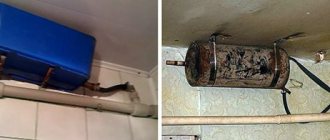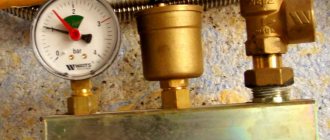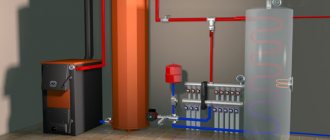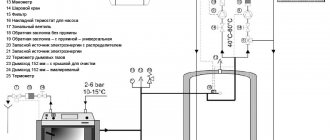It sounds confusing, but in reality everything is very simple: where is the supply and return in the heating system
The comfort of the family in winter will depend on how efficiently the heating system in the house operates .
If the batteries heat up poorly, it is necessary to eliminate the malfunction, and for this it is important to know how heating works in general. Water heating of space is a heat source and coolant, which is distributed through radiators . Supply and return are present in one- and two-pipe systems. In the second, there is no clear distribution; the pipe is conventionally divided in half.
Selecting pressure values in the system and expansion tank
Our task is to fill the empty water heating circuit.
Selection of coolant
First, a few words about what liquids can be used to fill the heating system. Here are the key properties of popular coolants.
The higher the operating pressure of the coolant, the less likely it is that air will enter the system. It is necessary to remember that the operating pressure is limited to the maximum permissible value for the heating boiler. If, when filling the system, a static pressure of 1.5 atm (15 m of water column) was reached, then the circulation pump with a pressure of 6 m of water. Art. will create a pressure of 15 6 = 21 m of water column at the entrance to the boiler.
Some types of boilers have a working pressure of about 2 atm = 20 m water column. Be careful not to overload the boiler heat exchanger with unacceptably high coolant pressure!
The membrane expansion tank is supplied with a factory set pressure of inert gas (nitrogen) in the gas cavity. Its common value is 1.5 atm (or bar, which is almost the same). This level can be raised by pumping air into the gas cavity with a hand pump.
Initially, the internal volume of the tank is completely occupied by nitrogen, the membrane is pressed against the body by the gas. That is why closed systems are usually filled to a pressure level of no higher than 1.5 atm (maximum 1.6 atm). Then, by installing the expansion tank on the “return” in front of the circulation pump, we will not get a change in its internal volume - the membrane will remain motionless.
Pressure levels in the expansion tank.
Filling the system to a pressure of 2 atm will allow the cold coolant to immediately press the membrane, which will also compress the nitrogen to a pressure of 2 atm. Heating water from 0 °C to 100 °C increases its volume by 4.33%. The additional volume of liquid must enter the expansion tank. The large volume of coolant in the system gives a large increase in its growth when heated.
Too much initial pressure of the cold coolant will immediately use up the capacity of the expansion tank; it will not be enough to receive excess heated water (antifreeze). Therefore, it is important to fill the system to the correctly determined coolant pressure level. When filling the system with antifreeze, you need to remember that its coefficient of thermal expansion is greater than that of water, which requires the installation of a larger capacity expansion tank.
Conclusion
Filling closed heating systems is not just a standard final step before commissioning. Correct or incorrect execution of this step can seriously affect the performance of the system, in the worst case, even destroy it. Compliance with filling technology is the key to obtaining stable heating.
How to implement alternative heating for a private home
- Two-pipe heating system for a private house - classification, types and practical design skills
- Single-pipe and two-pipe heating distribution in a private house
- Two-pipe heating system for a private house - classification, types and practical design skills
Conclusion
Where is the return route?
In short, the heating circuit consists of several important elements : a heating boiler, batteries and an expansion tank. In order for heat to flow through radiators, a coolant is needed: water or antifreeze . If the circuit is constructed correctly, the coolant heats up in the boiler, rises through the pipes, increasing its volume, and all excess ends up in the expansion tank.
Based on the fact that the batteries are filled with liquid, hot water displaces cold water , which, in turn, enters the boiler again for subsequent heating. Gradually the water temperature increases and reaches the desired temperature. circulation can be natural or gravitational , carried out using pumps.
Based on this, the return can be considered a coolant that has passed through the entire circuit, giving off heat, and, already cooled, returned to the boiler for subsequent heating.
Filling technology: where to supply coolant
The coolant is drained from the heating circuit in a private house during repair work.
The liquid is also removed in the spring and summer when the heating is turned off. This manipulation is performed to prevent corrosion, but it also leads to negative consequences: the appearance of air inside the system. This problem can lead to serious problems:
- the operational period of the structure is reduced, since air, when interacting with water, causes the formation of corrosion on the metal;
- the supply of coolant to the batteries deteriorates due to air locks.
For these reasons, the heating system in a private house is also filled in the summer, but only if the pipes are made of stainless materials.
The frequency of fluid replacement depends on what design is used to heat a private home:
- Experts advise regularly adding liquid to an open-type system, since the coolant constantly evaporates during the operation of the structure. The water is not completely drained here. An exception is repairs and sealing checks after washing.
- There is no need to constantly add coolant to a closed structure. The fluid is changed several years after the start of operation and after preventative flushing.
To fill the circuit of an open-type heating system, no devices are used. All you need is a clean bucket or hose for easy supply of liquid. Pour coolant into the expansion tank to the very top. Then deflate completely. If the water level in the tank drops below half, repeat the procedure. Release the air. The structure is ready for use. Repeat the procedure after a few weeks.
A closed heating system is filled with water in several ways.
Through recharge
Filling via make-up is only possible if the system is connected to a water supply. Work rules:
- Drain the old coolant.
- Open the tap located at the bottom of the boiler. After this, open the air bleed valve at the highest point. When the water comes out, turn off both taps.
- Start the boiler. If you hear any unusual sounds, remove the cover from the device and find the circulation pump.
- Loosen the screws, but do not remove them completely. Do not twist them until liquid appears. As soon as the coolant flows, the excess air will leave. Return the screws to the reverse position and close the boiler lid.
Important! Do not turn on the boiler at full power immediately after starting operation or filling the system. Rapid heating will cause water hammer and structural damage.
Pump
A pump is used to fill the circuit. Work algorithm:
- Connect the pump to the coolant tank and the heating circuit. Open the shut-off valve and valve on the expansion tank. Start the mechanism. The pump operates before the pressure reaches 1.5 atmospheres. Turn off the device and the circulation device.
- Open the Mayevsky taps. Air will escape through them. When liquid flows, close the taps.
- Start the pump. The unit will again increase the pressure to an acceptable level and fill the structure with coolant.
Even non-professionals do not have problems filling a double-circuit boiler, since the device is equipped with a make-up unit.
The algorithm for filling the circuit is similar to the rules for adding coolant through make-up:
- open all air bleed valves;
- activate the make-up valve;
- when water comes out, turn off the air release valves;
- when the pressure rises to the set limit, close the make-up.
Important! The maximum pressure limit is indicated in the unit passport. Exceeding the limit is unacceptable and leads to irreversible consequences.
A structure with an electric boiler is filled with coolant, like any closed heating system. If antifreeze is used for the circuit, then the rules for filling it will be different. The system is filled with non-freezing liquid in several ways:
- Manual pressure testing pump. The liquid is pumped by this device to the upper pressure limit.
- Electric pump. One end of it is connected to the container with the coolant, the other to the system. The liquid is pumped to the upper pressure limit. Then air is released from the circuit and the manipulation is repeated.
- Through the hose. The lower end is fixed on the non-return valve pipe, and the upper end is raised to the highest point of the system. After completing the work, place a container under the tap to drain excess liquid.
Monitoring the parameters of the heating system fluid guarantees a long operational period of the structure. The main criterion for assessing the coolant in an open circuit is the water level.
Such control is carried out through visual inspection of the expansion tank. The permissible limit is that the device is half full.
If the coolant drops below this value, then experts recommend adding water.
The next parameter to pay attention to is the temperature of the liquid. Optimal values are from 30 to 90 degrees Celsius. If the temperature rises above normal, the paint coating inside the circuit decomposes. This is prohibited by sanitary standards, so the liquid should not be allowed to boil.
To control the temperature, it is recommended to install a remote temperature sensor on the coolant pipe. Thick paper is placed between the pipe and the device. Thanks to this manipulation, the sensor will show an accurate value without errors. If the temperature is higher than the established norm, the boiler power is reduced and water is added if an open type design is used.
An important question that arises after the installation of heating devices is completed concerns how to fill a closed-type heating system and put it into operation. The process is simple, although its features cause typical difficulties for ordinary users. These include the choice of injection point and coolant pressure.
The open system is equipped with an expansion tank at its highest point. The surface of the coolant fluid in it is in direct contact with atmospheric air. The closed system is equipped with a membrane expansion tank, hermetically sealed from the atmosphere.
Heating systems of any type can be filled as follows:
- tap water supplied to the lowest point of the system - through the make-up valve;
- water (distilled) or antifreeze, supplying liquid from a container (well, reservoir):
- by pouring manually and/or using a pump to the top point (fitting under the air vent or through an open expansion tank);
- pumping through the lowest point - the make-up inlet.
Many homeowners know the simplest (and worst!) way to fill open systems through an expansion tank. Water/antifreeze is poured inside with breaks to release air. It is not recommended to repeat this method in closed systems using the pipes of the upper air vents. The air that initially fills the system passes up through the layer of water being poured, dissolving in it. Air locks that prevent the flow of water through pipes and radiators will be guaranteed.
Then how to fill a closed heating system? The recommended method of filling any heating systems is to supply fluid under pressure (from a water supply or container via a pump) through the bottom fill valve.
Location of the heating system make-up unit.
There are only two known situations that require this technological operation:
- putting heating into operation (at the beginning of the heating season);
- restart after repair work.
Typically, coolant water is drained in late spring for two reasons:
- Water inevitably becomes contaminated with corrosion products (inside radiators, metal-plastic and polypropylene pipes are not susceptible to it). If you leave old water for the new season, you risk breaking the circulation pump with solid contaminants.
- Flooded systems of country houses that have not been started can “defrost” during a sudden cold snap - such cases are not uncommon. In this sense, antifreeze coolant is preferable. The high-quality composition has high anti-corrosion properties, increasing the drain interval to 5-6 years. There are known cases of uninterrupted heating operation with the same volume of antifreeze for 15-17 years. It is recommended to drain low-quality antifreeze after 2-3 years.
Pumping antifreeze into the heating system.
The necessary means are a container and a pump that creates the required pressure of the coolant liquid. Submersible type “Gnome” or “Kid” are quite suitable (popular with gardeners who use them for watering areas located above the levels of reservoirs). There is evidence of successful filling of closed systems using hand pumps - from those used for spraying protective solutions on garden crops, to specialized hand pumps used for pumping motor fuels or liquid chemicals from drums. Any heating circuit can be successfully filled by monitoring the pressure using a pressure gauge.
Read more: Fillers for peat toilets: comparative review, tips for choosing - Superfb
Filling the system with antifreeze using a submersible vibration pump.
The first step is to select the fluid entry point. If the pressure created by the pump raises the liquid to the top of the system, it should be connected at the lowest point of the boiler room - the coolant make-up pipe, cut into the “return” in front of the boiler. In addition to the make-up inlet, a structurally separate drain outlet is required (two different system components).
The first is equipped with a valve (ball valve) and a check valve, the second - only with a valve (ball valve). If the lowest point of the system is the water drain fitting from the boiler, then you can drain/fill the system with water through it. Since a check valve is not installed behind the boiler drain (behind the drain at all), any shutdown of the pump will cause the pumped liquid to leak out - you need to quickly turn off the tap in front of the fitting.
Design of a typical drain/recharge unit.
So, let's get back to pumping fluid into the system. We use a container of suitable volume (a 200-liter plastic barrel works well). We lower a pump into it, creating the pressure required for pumping liquid no higher than 1.5 atm (typical value in the range of 1-1.2 atm). Such pressure requires the pump to create a pressure of 15 m (for the submersible “Malysh” it reaches 40 m).
- Filling the heating system with water
- Flushing the system before starting
- How to determine the amount of fluid for the system
- Classification of heating systems
- Basic methods of filling the system
- How to fill the heating system in an apartment building
- The process of starting an open gravity heating system
- Filling a closed heating system
- Removing air pockets, starting the heating system
- Reduced efficiency in heating operation. This is a consequence of a decrease in heat transfer efficiency due to the presence of third-party elements in the liquid - limescale and rust.
- The likelihood of failure of the heating boiler, radiators and shut-off valves. Only by filling the heating with coolant can such problems be avoided. This is due to the gradual saturation of water with oxygen, as a result of which foaming increases and corrosion processes on the inner surface of the steel elements of the system are significantly accelerated.
- The old coolant is drained and the pipes are cleaned.
- The Mayevsky tap opens on all heating appliances.
- The liquid to fill the heating system can be supplied through the return pipe.
- As soon as all the air has left the system, the water level in the expansion tank is checked. It should be 2/3 full.
Differences between them
The difference between the described concepts is as follows:
- The supply is a coolant that flows through the radiators from the heat source.
- The return is a liquid that has passed through the entire circuit, and cooled down again to the heat source for subsequent heating. Therefore, occurs at the output .
- The difference is in temperature: the return is colder .
- The difference is in the installation. The water line that is attached to the top of the battery is the supply. What is attached to the bottom is the return line.
Important! Some tips need to be followed. The entire system must be completely filled with water or antifreeze . Maintaining fluid speed, circulation and pressure is equally important.
Temperature difference across radiators
The temperature difference should be 30 °C . In this case, the batteries will feel approximately the same to the touch . It is important to ensure that the difference in these values is not too large.
Photo 2. Heating diagram for 6 radiators: changes in flow and return temperatures on each of them are indicated.
When filling with coolant
If the system is not being filled for the first time, then during its service life, substances dangerous to proper operation, such as scale and limestone, have accumulated in the heating registers and pipes. All these products can cause serious damage to the boiler and the entire system.
Water heating scheme.
If there is water in the heating system, it must be drained. Next, you should dismantle the heating radiators. Then connect the pipes for supplying water from the water supply system to the outlet of the system, and the drain pipe to the entrance to the system. All formed connections must be well secured with pre-prepared clamps.
It should be remembered that the higher the pressure the water is supplied with, the better the cleaning will be (but not more than two atmospheres). A pump is usually used to create pressure. You can sprinkle bleach on the water to achieve a disinfectant effect. On average, this procedure can take about two hours. Upon completion, clean water without additional impurities will come out of the drain.
The heating system can be cleaned using special chemicals: additives or anti-corrosion liquids. They should be treated with caution, since they are not suitable for all materials and can damage some elements of the system.
After cleaning, the radiators are installed in the opposite direction of their dismantling. You should additionally check the tightness of the system by visual inspection and identifying leaks.
Excess air will come out of the pipes during the first fire through the expander. It should be noted that during the heating season, when the system maintains a constantly high temperature, water will gradually evaporate from the expander. It is necessary to recharge by adding water to the expander to the required level.
Before pumping, you need to hermetically seal the pump with the prepared hoses using clamps. Fill the prepared tank with water and place it near the system filling tap. The pump should also be located nearby. The hose that takes in water should be lowered into the tank, and the hose that supplies the pumped water should be secured with a clamp to the filling valve.
Read more: Computer socket categories and connection technology
Taps and dampers for venting the heating complex must be open. Turn on the pump and start pumping water into the pipes. The pressure on the pressure gauge should gradually increase. When the entire circuit is filled, the pressure gauge readings should reach two atmospheres. Afterwards the pump should be turned off. Disconnect the hoses and turn off the fill valve.
If it is not possible to use a pump to fill the heating complex, then you can use a water supply. The scheme is quite similar to the one described above. It is enough to attach one end of the water intake hose to the water tap, and the other end to the filler in the system and gradually open first the filler and then the water supply. In this case, the pressure will have to be monitored additionally using a separate pressure gauge.
The final operation of filling the system with water will be to remove excess air from its circuit. Modern installations provide special devices for this purpose. You can ventilate the system using this device on the bypass.
Filling the heating system will be most convenient when two people work, since throughout the entire filling process it is necessary to simultaneously monitor the pressure level in the system and the operation of the pump, being near the injection valve, and monitor the tightness and the process of de-aeration of the heating radiators.
Scheme for removing air locks from the heating system.
Despite being completely filled, the heating complex can accumulate air, which will subsequently cause increased susceptibility to corrosion of the internal parts of the pipeline and radiators and lead to constant noise and knocking throughout the entire system. Air remains in the pipes due to the presence of multiple turns of air in the water being released and leaky sealed connections.
To release excess air from the heating pipes after it has been filled, you need to open the air dampers and taps and wait up to three hours. This is necessary so that all air bubbles from the inner walls of the heating devices rise to the surface and exit through special holes. Using a vibration pump will help facilitate the process.
At the end of the process, it is necessary to close all the dampers and create the necessary pressure for correct operation in the system; it should be at the level of one and a half atmospheres. Equalize the pressure by topping up - adding the missing amount of water. After launch, the pressure will rise to two atmospheres.
Now you can start launching the heating complex. If the heating is new and is being started for the first time, then, under the terms of the warranty agreement, this work is performed by specialists from the manufacturer’s authorized service centers. Repeated launches are carried out independently. The heating complex is tested by gradual heating throughout the day.
If no shortcomings are identified in the heating complex, then it can be brought to full power. It is worth noting that the first two weeks of operation of the system may be accompanied by knocking noises in the pipe distribution. This should not be alarming, since all the air cannot be released during deflation; it eliminates itself during operation.
All necessary measures should be completed in time for the heating season.
But if there is a possibility of exposure to negative temperatures, then water as a liquid for filling heating systems is unacceptable. In this case, you should use antifreezes with a crystallization threshold significantly lower than 0°C. The best option is solutions of propylene glycol or glycerin with special additives.
They belong to the class of harmless substances and are used in the food industry. Solutions based on ethylene glycol have the best technical qualities. Until recently, they were used to fill closed heating systems. However, they are extremely harmful to humans. Therefore, despite all their positive qualities, the use of ethylene glycol-based antifreeze is not recommended.
But what can you fill the heating system with - water or antifreeze? If there is no chance of exposure to low temperatures, water is the best choice. Otherwise, it is recommended to use special coolant solutions.
Automotive antifreeze cannot be poured into the heating system. This will not only lead to boiler breakdown and failure of radiators, but will also be hazardous to health.
Used liquid must not be discharged into the sewer system. It must be collected in sealed containers, which are subsequently disposed of by special companies.
- It is necessary to make sure that all shut-off valves are in the required position - the drain valve is closed as well as the safety valves;
- The Mayevsky tap at the top point of the system must be open. This is necessary to remove air;
- The water is filled until water flows from the Mayevsky tap, which was opened earlier. After this it is blocked;
- Then it is necessary to remove excess air from all heating devices. An air valve must be installed on them. To do this, you need to leave the system filling valve open, making sure that the air comes out of the specific device. As soon as water flows from the valve, it must be closed. This procedure must be done for all heating devices.
After water has been filled into a closed heating system, you need to check the pressure parameters. It should be 1.5 bar. Subsequently, pressing is performed to prevent leaks. It will be discussed separately.
Before you begin the procedure of adding antifreeze to the system, you need to prepare it. Usually 35% or 40% solutions are used, but to save money it is recommended to purchase a concentrate. It should be diluted strictly according to the instructions, and only using distilled water. In addition, it is necessary to prepare a hand pump to fill the heating system.
- Air outlet from the system (Maevsky valve);
- Pressure in pipes. It should not exceed 2 bar.
The entire further procedure is completely similar to that described above. However, you should take into account the operating features of antifreeze - its density is much higher than that of water. Therefore, special attention should be paid to calculating the pump power. Some glycerin-based formulations may increase the viscosity coefficient as the temperature increases.
Before pouring antifreeze, it is necessary to replace the rubber gaskets at the joints with paronite gaskets. This will significantly reduce the likelihood of leaks.
For double-circuit boilers, it is recommended to use a device for automatically filling the heating system. It is an electronic control unit for adding water to the pipes. It is installed on the inlet pipe and operates fully automatically.
The main advantage of this device is the automatic maintenance of pressure by timely addition of water to the system. The principle of operation of the device is as follows: a pressure gauge connected to the control unit gives a signal about a critical decrease in pressure. The automatic water supply valve opens and remains in this state until the pressure stabilizes. However, almost all devices for automatically filling heating systems with water are expensive.
- Pressure. Pressure gauges must be installed in key places in the system - the outer radiators and the highest point. After the final release of air, the pressure on all pressure gauges should be the same;
- No leaks.
- Initial start-up of heating in a private house.
- Bringing the heating system into working condition after planned or unforeseen repairs or replacement of the boiler, shut-off fittings, and other elements.
- Refilling before the heating period after draining the coolant from the heating system in a house that has not been heated for a long time.
- It is necessary to make sure that all shut-off valves are in the required position - the drain valve is closed as well as the safety valves;
- The Mayevsky tap at the top point of the system must be open. This is necessary to remove air;
- The water is filled until water flows from the Mayevsky tap, which was opened earlier. After this it is blocked;
- Then it is necessary to remove excess air from all heating devices. An air valve must be installed on them. To do this, you need to leave the system filling valve open, making sure that the air comes out of the specific device. As soon as water flows from the valve, it must be closed. This procedure must be done for all heating devices.
- Pressure. Pressure gauges must be installed in key places in the system - the outer radiators and the highest point. After the final release of air, the pressure on all pressure gauges should be the same;
- No leaks.
- The old coolant is drained and the pipes are cleaned.
- The Mayevsky tap opens on all heating appliances.
- The liquid to fill the heating system can be supplied through the return pipe.
- As soon as all the air has left the system, the water level in the expansion tank is checked. It should be 2/3 full.
Read more: Wiring diagram for a two-button switch for two light bulbs, installation
Selection of coolant
Comparison results
Summing up, it becomes clear that a single-pipe distribution system with a return has the greatest prospects , especially for multi-storey buildings. Ease of installation, low cost and a small number of communications still have an advantage over a two-pipe with supply.
However, do not forget that using a two-pipe circuit, it is possible to regulate the heating temperature for each device separately.
How to find the supply and return pipelines for heating an apartment
Why is it necessary?
It is important for every apartment owner to know where the central heating input is located. Because, if a coolant leak occurs on any section of the pipeline or radiators, you need to react quickly and turn off the shut-off valves at the heating inlet to the apartment, in order to avoid flooding your apartment and the apartments of your neighbors below you. Since the pressure in centralized heating systems of apartment buildings is 3-5 Bar (atmospheres), the slightest leak will quickly turn into a deep river of boiling water (the temperature of the heating system varies from 40 to 90 °C).
Depending on the characteristics of the intra-house heating system, the input of thermal energy into the apartment may be located:
- directly in the apartment itself, in which case all that remains is to find out where the supply is and where the return is.
- in the heating niche located in the corridor on the floor where the apartment is located;
- in the heating niche located in the corridor 1 floor below the apartment;
- in the heating niche located in the corridor 1 floor above the apartment;
We will consider cases 2-4 in more detail below.
If each of the apartments has its own heating niche located near/under/above the entrance to the apartment, then all that remains is to find out where the supply is and where the return is.
In cases where we are dealing with combined heating niches (1 niche for the entire floor, 1 niche for every 2-4 apartments), a seemingly easy task can turn out to be a serious challenge. Everything is decided by chance. The following options are possible:
1. Numbering – trust, but verify!
If builders or operating organizations have numbered the outlets from the heating system comb, there is a possibility that your apartment number and the outlet number will match, and the search process will come to its logical conclusion. However, as the famous proverb said, “Trust, but verify!” How to do this is described below in this article.
2. The pipes do not intersect.
Builders often follow this rule when installing heating systems. Based on it, you can conduct a visual analysis of the direction of laying pipelines and find your pipes. However, in our country everything is possible and both written and unwritten rules, as well as any elementary logic and rationality, can be violated. So, if you want to be sure of something, check it yourself.
3. Plans and drawings do not correspond to harsh reality.
Armed with a floor-by-floor layout diagram of heating networks and engineering drawings, you can also get into trouble. Due to the fact that there is often a big difference between the project and the actual execution, it begins with the developer’s banal desire to save money and ends with the arbitrariness of the builders. So, if you want to be sure of something, check it yourself.
4. Clinical cases.
Sometimes you can simply encounter clinical cases of general negligence and irresponsibility, when, in the process of research, it is revealed that your incoming and outgoing pipes are not located symmetrically one below the other, but are located at different poles of the comb. That is, for example, your incoming pipe on the comb is the 1st on the left, and the outgoing pipe is the 2nd on the right.
Let's move directly to the methods of searching for the pipelines we need in the heating niche of the apartment located on the floor/above/below it.
All methods of searching for heating system pipes that lead to your home can be divided into two periods:
1) Autumn-spring period of operation of the centralized heating system.
What does this graph look like?
To track the dependence of external temperature on coolant parameters, you should familiarize yourself with the special table, which is also valid in 2021.
The lower the thermometer on the street, the higher the inlet values, and they decrease not only after entering the heating system, but also into devices located in the living space of the city of Moscow and any other populated area.
| Outdoor temperature, degrees | Water indicators at the entrance to the building | Characteristics in the heating system, minimum | Heating the coolant after passing through the system |
| 8 | 45-52 | 40 | 34 |
| 7 | 47-55 | 41 | 35 |
| 6 | 49-57 | 43 | 36 |
| 5 | 50-59 | 44 | 37 |
| 4 | 52-61 | 45 | 38 |
| 3 | 54-64 | 47 | 39 |
| 2 | 56-66 | 48 | 40 |
| 1 | 57-69 | 50 | 41 |
| 0 | 59-71 | 51 | 42 |
| -1 | 61-73 | 52 | 43 |
| -2 | 62-76 | 54 | 44 |
| -3 | 64-78 | 55 | 45 |
| -4 | 66-80 | 56 | 45 |
| -5 | 67-82 | 57 | 46 |
| -6 | 69-85 | 59 | 47 |
| -7 | 71-87 | 60 | 48 |
| -8 | 72-89 | 61 | 49 |
| -9 | 74-92 | 63 | 49 |
| -10 | 75-94 | 64 | 50 |
| -15 | 83-105 | 70 | 54 |
| -20 | 91-116 | 76 | 58 |
| -25 | 98-128 | 82 | 62 |
| -30 | 106-138 | 88 | 67 |
| -35 | 114-149 | 94 | 69 |
Utility workers in St. Petersburg carry out control measurements to determine compliance with standards, but there are nuances associated with pipes for hot coolant and return.
Input numbers are indicated without heat losses that occur when transporting hot water.
At the same time, the schedule is needed not only by suppliers, but also by consumers, who, if the indicators are insufficient and do not correspond to the norm, may require recalculation.
The complaint should indicate what outdoor temperature is maintained in the room, and an appeal is filed on this basis.
Based on this, controllers conduct studies of the coolant, and if it does not comply with the developed schedule, the organization will pay compensation and will be obliged to establish a normal supply to the consumer.
How to determine where the heating supply is?
Two rooms on the 4th floor. In the first, the riser goes through the radiator to the 5th floor, there it spreads into the next room and goes down through the radiator, i.e. this is one circuit. In 1 room there are 10 bimetal sections. The supply pipes are hot, the battery is heated by the triangle. From about section 5, the temperature at the bottom of the radiator begins to drop. The upper manifold is all hot. In the second room there are 8 bimetal sections. The battery is all uniformly hot. I suspect that in an unheated battery the supply comes from below? Selfish question, I’m going to insert a tube into the supply to lengthen the flow.
2Mishutk IMHO, the most accurate diagnosis can be made by visiting the basement, where everything is.
2Mishutk TOUCH THE RISERS THAT ARE HOT AND SERVED
No basement. In terms of riser temperature, both are subjectively the same. Just poke it with a thermometer.
I thought about shutting off the battery (there is a bypass), letting it cool, then opening it slightly and feeling where it starts to warm up.
or catch the Zhekovsky plumber. he knows for sure.
Mishutk wrote: In terms of riser temperature, both are subjectively the same. Just poke it with a thermometer.
yes, your penultimate floor is a little complicated, but on the first or second, if you touch it with your neighbors, it will immediately become clear
You can take (buy, ask for) a digital multimeter (and sensor) and measure the temperature. Many multimeters have a temperature measurement function. It is better to do this in cold weather, because... The temperature difference even in cold weather is not very big. The position of the sensor relative to the pipe should be the same in the measurements. There should be several measurements.
2Akim And you can miss with it in this situation, we have a TC - 3M, contact digital, old stuff, of course, in such a situation not the best assistant.
2Suever In order not to miss, you must comply with the following conditions:
- sensor relative to the pipe in one position (or isolate the sensor from air flows)
- for accuracy, take 10 measurements, min. and max. discard the values and find the average (this is like the maximum program)
2Akim This is not all, clean the pipe with a file, down to the metal, lubricate the surface with Vaseline and apply a temperature probe, only in the basement it will be simple, quick and 100%, and believe me, there are many ways to get there.
Here, on this forum, the simplest method has already been proposed, without instruments, by touch. It couldn't be simpler.
To do this, it is necessary to stop the movement of water in the battery and allow it to cool. Such a tap for every battery is highly desirable. Then turn on the water supply and keep your hands on both pipes. Two hands are enough. The pipe that starts to heat up first. will point you in the direction of the water.
Grandfather simply wrote: To do this, you need to stop the movement of water in the battery and let it cool. Such a tap for every battery is highly desirable. Then turn on the water supply and keep your hands on both pipes. Two hands are enough. The pipe that starts to heat up first. will point you in the direction of the water
Temperature schedule for coolant supply to the heating system: SNIP 2021
The temperature of the water in the heating system depends on the air temperature outside and is maintained in it according to a special temperature schedule, which is calculated differently by specialists for different heat supply sources, depending on local weather conditions.
If you want to find out how to solve your specific problem, please contact the online consultant form on the right. It's fast and free! Or call us at :
As already mentioned, the temperature graph directly depends on the outside air temperature. Accordingly, the lower the air temperature, the greater the heat loss.
The question arises, what temperature indicator should be used in the calculation? This indicator has already been derived and can be found in regulatory documents.
It is based on the average temperature of the five coldest days of the year. In this case, a period of 50 years is taken, and the 8 coldest winters are selected.
Why is the average daily temperature calculated this way?
First of all, this makes it possible to be prepared for low temperatures during the winter season, which occur once every few years.
Also, taking this indicator into account, you can significantly save on costs when creating heating systems. If we consider this in the volume of mass construction, the amount that can be saved will be significant.
Of course, the temperature of the heated room will depend on the temperature of the coolant.
What temperature should the apartment be during the heating season?
Read about the normal temperature of batteries in an apartment here.
There are several other factors that also affect indoor temperature:
- The lower the air temperature outside, the lower it is indoors;
- Wind speed also affects the temperature. The stronger the wind loads, the more heat loss through window frames and entrance doors increases;
- How tightly are the joints in the walls of the house sealed? For example, insulation of the facade walls of a house or metal-plastic windows are factors that will affect the temperature inside the room.
Today, building codes have changed. Construction companies increase the value of their facilities through thermal insulation work, such as insulation of the facade of the house, basements, foundation, roof and roofing.
The costs of insulating a house are quite high, but this is a guarantee that in the future you will save on heating, since these measures reduce the cost of purchasing fuel.
How relevant is this today? Of course, it is for this reason that construction companies increase the cost of building houses, knowing that measures to insulate the house will, over time, pay off with interest.
Radiator temperature
Everything mentioned above is certainly important. But the main thing that affects the temperature in the rooms is the temperature of the radiator batteries. As a rule, the temperature in central heating systems ranges from 70 to 90 degrees.
Everyone knows that it is impossible to achieve the desired temperature inside a room using this criterion alone, taking into account the fact that the temperature in all rooms should be different, since each room has its own purpose:
- If the room is corner, then the temperature should not fall below + 20 0 C, and in other rooms the temperature is not lower than +18 0 C, in the shower room not lower than +25 0 C. If the temperature outside drops to -30 0 C or lower, then all the above indicators will increase to +22 0 C and 20 0 C, respectively;
- In rooms intended for children - from +18 0 C to +23 0 C. But even here the temperature regime depends on what this room is intended for. In the pools - not lower than +30 0 C, and on the verandas for walking - not lower than +12 0 C;
- In children's schools - not lower than 21 0 C, and in the bedrooms of boarding schools - not lower than 16 0 C;
- In cultural institutions the temperature ranges from 16 0 C to 21 0 C. For libraries - up to 18 0 C.
Temperature standards are approved for all premises depending on their purpose. The above is only a small part of a huge list.
The normal temperature in a room is affected by how intensely a person moves inside it. The fewer movements a person makes, the higher the temperature in the room should be.
The heat distribution is based on this. As evidence, in sports institutions where a person is on the move, it is not advisable to maintain the temperature at a high level; for this reason, the temperature there is no higher than +18 0 C.
Factors affecting battery temperature:
- Outside temperature;
- Type of heating system. For a single-pipe system, the standard temperature indicator is +105 0 C, and for a two-pipe system +95 0 C. The temperature difference in the supply and discharge system should not be higher than 105-70 0 C and 95-70 0 C, respectively;
- Direction of coolant flow to radiator batteries. If the wiring is from above, then the difference is 2 0 C, and if the wiring is from below, then 3 0 C;
- Type of heating device. Radiators and convectors have different heat output, which means the temperature regime is different. Radiators have higher heat transfer than convectors.
But still, everyone understands that heat transfer, be it a radiator or a convector, will depend on the temperature outside.
Depending on the outside temperature, the coolant temperature values are calculated and have the following values (these temperature indicators are rounded for convenience):
Economical energy consumption in the heating system can be achieved if certain requirements are met. One option is to have a temperature diagram, which reflects the ratio of the temperature emanating from the heating source to the external environment. The values of the values make it possible to optimally distribute heat and hot water to the consumer.
High-rise buildings are mainly connected to central heating. The sources that transmit thermal energy are boiler houses or thermal power plants. Water is used as a coolant. It is heated to a given temperature.
Having gone through a full cycle through the system, the coolant, already cooled, returns to the source and reheats. Sources are connected to consumers by heating networks. Since the environment changes temperature, thermal energy should be adjusted so that the consumer receives the required volume.
Heat regulation from the central system can be done in two ways:
- Quantitative. In this form, the water flow changes, but its temperature remains constant.
- Qualitative. The temperature of the liquid changes, but its flow does not change.
In our systems, the second regulation option is used, that is, qualitative. Here there is a direct relationship between two temperatures: the coolant and the environment. And the calculation is carried out in such a way as to ensure the heat in the room is 18 degrees and above.
Hence, we can say that the temperature graph of the source is a broken curve. The change in its directions depends on temperature differences (coolant and outside air).
The dependency schedule may vary.
A specific diagram has a dependency on:
- Technical and economic indicators.
- CHP or boiler room equipment.
- Climate.
Below is an example of a diagram, where T1 is the coolant temperature, Tnv is the outside air:
A diagram of the returned coolant is also used. A boiler house or thermal power plant can estimate the efficiency of the source using this scheme. It is considered high when the returned liquid arrives chilled.
This is interesting: Decree of the Government of the Russian Federation No. 491 of August 13, 2006. 2021
The stability of the scheme depends on the design values of fluid flow of high-rise buildings. If the flow through the heating circuit increases, the water will return uncooled, as the flow rate will increase. Conversely, with minimal flow, the return water will be sufficiently cooled.
The supplier's interest, of course, is in the supply of return water in a cooled state. But there are certain limits for reducing consumption, since a decrease leads to loss of heat. The consumer’s internal temperature in the apartment will begin to drop, which will lead to violation of building codes and discomfort for ordinary people.
The temperature curve depends on two quantities: outside air and coolant. Frosty weather leads to an increase in coolant temperature. When designing a central source, the size of the equipment, building and pipe size are taken into account.
The temperature leaving the boiler room is 90 degrees, so that at minus 23°C, the apartments are warm and have a value of 22°C. Then the return water returns to 70 degrees. Such standards correspond to normal and comfortable living in the house.
Analysis and adjustment of operating modes is carried out using a temperature diagram. For example, the return of liquid with an elevated temperature will indicate high coolant costs. Underestimated data will be considered a consumption deficit.
Temperature chart 95-70:
Temperature chart 95-70
A control method is selected, then a calculation is made. The calculated winter and reverse order of water supply, the amount of outside air, and the order at the break point of the diagram are taken into account. There are two diagrams: one of them considers only heating, the second considers heating with hot water consumption.
For an example of calculation, we will use the methodological development of Roskommunenergo.
The input data for the heat generating station will be:
- Tnv – the value of outside air.
- TV - indoor air.
- T1 – coolant from the source.
- T2 – reverse flow of water.
- T3 – entrance to the building.
We will look at several heat supply options with values of 150, 130 and 115 degrees.
At the same time, at the exit they will have 70°C.
The results obtained are compiled into a single table for subsequent construction of the curve:
So, we have three different schemes that can be used as a basis. It would be more correct to calculate the diagram individually for each system. Here we examined the recommended values, without taking into account the climatic features of the region and the characteristics of the building.
To reduce energy consumption, it is enough to select a low temperature setting of 70 degrees and uniform heat distribution throughout the heating circuit will be ensured. The boiler should be taken with a power reserve so that the system load does not affect the quality operation of the unit.
Automatic control is provided by the heating regulator.
It includes the following parts:
- Computing and matching panel.
- Actuating device on the water supply section.
- An actuator that performs the function of mixing liquid from the returned liquid (return).
- Boost pump and sensor on the water supply line.
- Three sensors (on the return line, on the street, inside the building). There may be several of them in the room.
The regulator closes the liquid supply, thereby increasing the value between return and supply to the value specified by the sensors.
To increase the flow, there is a boost pump and a corresponding command from the regulator. The incoming flow is controlled by a "cold bypass". That is, the temperature decreases. Some of the liquid that has circulated along the circuit is sent to the supply.
Sensors collect information and transmit it to control units, resulting in a redistribution of flows that provide a rigid temperature scheme for the heating system.
Sometimes, a computing device is used that combines hot water and heating regulators.
The hot water regulator has a simpler control scheme. The hot water sensor regulates the flow of water with a stable value of 50°C.
Advantages of the regulator:
- The temperature scheme is strictly maintained.
- Elimination of overheating of the liquid.
- and energy efficiency
- The consumer, regardless of the distance, receives heat equally.
The operating mode of boilers depends on the environmental weather.
If we take various objects, for example, a factory building, a multi-storey building and a private house, they will all have an individual thermal diagram.
In the table we show the temperature diagram of the dependence of residential buildings on outside air:
There are a number of patterns on the basis of which the temperature of the coolant in central heating changes. To track fluctuations, there are special graphs called temperature graphs. What they are and what they are needed for needs to be understood in more detail.
The temperature graph of a heating system is the dependence of the temperature of the coolant, which is water, on the temperature of the outside air.
The main indicators of the graph under consideration are two values:
- The temperature of the coolant, that is, the heated water that is supplied to the heating system to heat residential premises.
- Outdoor air temperature readings.
The lower the ambient temperature, the more it is necessary to heat the coolant that is supplied to the heating system. The schedule under consideration is constructed when designing heating systems for buildings. It determines indicators such as the size of the heating devices, the coolant flow rate in the system, as well as the diameter of the pipelines through which the coolant is transferred.
The temperature graph allows you to determine whether the coolant flow rate is too high or low. If the temperature of the returned coolant is too high, this will indicate a high flow rate. If the value is underestimated, this indicates a consumption deficit.
The reasons for temperature changes are determined by the following factors:
- When weather conditions change, heat loss automatically changes. When cold weather sets in, to ensure an optimal microclimate in apartment buildings it is necessary to expend more thermal energy than during warming. The level of heat loss consumed is calculated by the “delta” value, which is the difference between the street and indoors.
- The constancy of the heat flow from the batteries is ensured by a stable temperature of the coolant. As soon as the temperature decreases, apartment radiators will become increasingly warmer. This phenomenon is facilitated by an increase in the “delta” between the coolant and the air in the room.
The increase in coolant losses must be carried out in parallel with the decrease in air temperature outside the window. The colder it is outside, the higher the temperature of the water in the heating pipes should be. To facilitate the calculation processes, a corresponding table has been adopted.
The temperature graph for coolant supply to heating systems is a table that lists the coolant temperature values depending on the outside air temperature.
A generalized graph of water temperature in the heating system is as follows:
The formula for calculating the temperature graph is as follows:
- To determine the coolant supply temperature: T1=tin+∆xQ(0.8)+(β-0.5xUP)xQ.
- To determine the return supply temperature, the formula is used: T2=tin+∆xQ(0.8)-0.5xUPxQ.
In the presented formulas:
Q – relative heating load.
∆ is the temperature pressure of the coolant supply.
β – temperature difference in forward and reverse supply.
UP is the difference in water temperature at the inlet and outlet of the heating device.
There are two types of graphs:
- For heating networks.
- For apartment buildings.
To understand the details, let’s consider the features of the functioning of centralized heating.
The purpose of thermal power plants and heating networks is to heat the coolant to a certain value, and then transport it to the place of consumption. It is important to take into account the losses on the heating main, the length of which is usually 10 kilometers. Despite the fact that all water supply pipes are thermally insulated, it is almost impossible to avoid heat losses.
This is interesting: Electricity tariffs for enterprises: description of tariffs 2021
When the coolant moves from a thermal power plant or simply a boiler house to the consumer (apartment building), a certain percentage of water cooling is observed. To ensure the supply of coolant to the consumer at the required standardized value, it is required to be supplied from the boiler room in the maximum heated state. However, it is impossible to increase the temperature above 100 degrees, since it is limited by the boiling point. However, it can be shifted towards increasing the temperature value by increasing the pressure in the heating system.
The pressure in the pipes according to the standard is 7-8 atmospheres, however, when the coolant is supplied, a loss of pressure also occurs. However, despite the pressure loss, a value of 7-8 atmospheres allows for efficient operation of the heating system even in 16-story buildings.
This is interesting! The pressure in the heating system of 7-8 atmospheres is not dangerous for the network itself. All structural elements remain operational in normal mode.
Taking into account the reserve of the upper temperature threshold, its value is 150 degrees. The minimum supply temperature at sub-zero temperatures outside the window is not below 9 degrees. The return temperature is usually 70 degrees.
The following restrictions apply to the home heating system:
- The maximum heating indicator is determined by a limited value of +95 degrees for a two-pipe system, as well as 105 degrees for a single-pipe network. In preschool educational institutions, stricter restrictions apply. The water temperature in the battery should not rise above 37 degrees. To compensate for the reduced temperature, additional sections of radiators are built up. Kindergartens, which are located directly in regions with harsh climatic zones, are equipped with a large number of radiators with numerous sections.
- The best option is to achieve the minimum “delta” value, which represents the difference between the supply and return values of the coolant temperature. If you do not achieve this value, then the degree of heating of the radiators will have a large difference. To reduce the difference, it is necessary to increase the speed of the coolant. However, even with an increase in the speed of movement of the coolant, a significant drawback arises, which is due to the fact that the water will return back to the thermal power plant with an excessively high temperature. This phenomenon can lead to disruptions in the functioning of the thermal power plant.
To get rid of this problem, elevator modules should be installed in every apartment building. Through such devices, a portion of supply and return water is diluted. This mixture will allow for accelerated circulation, thereby eliminating the possibility of excessive overheating of the return pipeline.
The main factor that is taken into account when calculating the temperature schedule is presented in the form of the calculated temperature in winter. When calculating heating, the outside air temperature is taken from a special table for climatic zones.
The coolant temperature table should be drawn up so that its maximum value satisfies the SNiP temperature in residential premises. For example, we use the following data:
- Radiators are used as heating devices, which supply coolant from bottom to top.
- The type of apartment heating is two-pipe, equipped with parking pipe distribution.
- The calculated values of the outside air temperature are -15 degrees.
In this case we receive the following information:
- Heating will be started when the average daily temperature does not exceed +10 degrees for 3-5 days. The coolant supply will be carried out at a value of 30 degrees, and the return will be equal to 25 degrees.
- When the temperature drops to 0 degrees, the coolant value increases to 57 degrees, and the return flow will be 46 degrees.
- At -15, water will be supplied at a temperature of 95 degrees, and the return will be 70 degrees.
This is interesting! When determining the average daily temperature, information is taken from both daytime thermometer readings and nighttime measurements.
CHP workers are responsible for the parameters of heating mains, but monitoring of networks inside residential buildings is carried out by employees of the housing office or management companies. The Housing Office often receives complaints from residents that their apartments are cold. To normalize the system parameters, you will need to take the following measures:
- Increasing the nozzle diameter or installing an elevator with an adjustable nozzle. If there is an underestimated value of the liquid temperature in the return, then this problem can be solved by increasing the diameter of the elevator nozzle. To do this, you need to close the latches and valves, and then remove the module. The nozzle is enlarged by drilling it by 0.5-1 mm. After completing the procedure, the device is returned to its place, after which the procedure of bleeding air from the system must be carried out.
- Stop the choke. To avoid the threat of the suction pump performing the function of a jumper, it is silenced. To perform this procedure, a steel pancake is used, the thickness of which should be about 1 mm. This method of temperature control belongs to the category of emergency options, since when it is carried out, it is possible that a temperature jump of up to +130 degrees may occur.
- Regulation of differences. The problem can be resolved by adjusting the differences with an elevator valve. The essence of this correction method is to redirect the hot water to the supply pipe. A pressure gauge is screwed into the return pipe, after which the valve of the return pipeline is closed. When opening the valve, you need to check the pressure gauge readings.
If you install a conventional valve, this will lead to the system stopping and freezing. To reduce the difference, you need to increase the return pressure to 0.2 atm/day. You can find out what temperature the batteries should be based on the temperature graph. Knowing its value, you can check to ensure its compliance with the temperature regime.
In conclusion, it should be noted that options for suppressing suction and regulating differences are used exclusively in the development of critical situations. Knowing this minimum of information, you can contact the housing office or thermal power plant with complaints and wishes about the coolant in the system that does not meet the standards.
The standard water temperature in the heating system depends on the air temperature. Therefore, the temperature schedule for supplying coolant to the heating system is calculated in accordance with weather conditions. In this article we will talk about the SNiP requirements for the operation of a heating system for objects for various purposes.
In order to economically and rationally use energy resources in the heating system, the heat supply is tied to the air temperature. The relationship between the temperature of the water in the pipes and the air outside the window is displayed in the form of a graph. The main task of such calculations is to maintain comfortable conditions for residents in apartments. To do this, the air temperature should be about +20…+22ºС.
The stronger the frost, the faster living spaces heated from the inside lose heat. To compensate for the increased heat loss, the temperature of the water in the heating system increases.
The standard temperature indicator is used in the calculations. It is calculated using a special method and entered into the management documentation. This indicator is based on the average temperature of the 5 coldest days of the year. For the calculation, the 8 coldest winters over a 50-year period are taken.
Why does drawing up a temperature schedule for the supply of coolant to the heating system happen this way? The main thing here is to be prepared for the most severe frosts, which happen every few years. Climatic conditions in a particular region can change over several decades. This will be taken into account when recalculating the schedule.
Useful
It sounds confusing, but in reality everything is very simple: where is the supply and return in the heating system
The comfort of the family in winter will depend on how efficiently the heating system in the house operates . If the batteries heat up poorly, it is necessary to eliminate the malfunction, and for this it is important to know how heating works in general.
Water heating of space is a heat source and coolant, which is distributed through radiators . Supply and return are present in one- and two-pipe systems. In the second, there is no clear distribution; the pipe is conventionally divided in half.
Why do batteries in a private house not warm up well?
Just as in the case of a high-rise building, there may be several reasons for the poor performance of heating batteries in a private house.
Reason 1: problems in the hydraulics of the heating system
The most common reason why radiators remain cold is due to the hydraulics of the heating system. In this case, one of the heating branches is working properly, and the second is intermittent. This picture is typical for a new heating system or when adding radiators to an existing one. If the hydraulics are incorrectly calculated, and in particular the diameters and lengths of pipes, some batteries may simply not heat up. You can adjust the hydraulics using special taps.
Reason 2: single-pipe heating system
In many private homes there are single-pipe heating systems. In such a system, batteries remote from the boiler often heat much worse than those nearby. This does not mean that there are problems; this is the nature of the operation of a single-pipe system. The only solution here can only be to replace the system with a two-pipe one.
Reason 3: boiler malfunction
The batteries may not warm up due to malfunctions in boilers with built-in automation, pumps and sensors, which is a typical problem for autonomous heating systems. In this case, you must contact a specialist who works with such equipment directly.
Differences between them
The difference between the described concepts is as follows:
- The supply is a coolant that flows through the radiators from the heat source.
- The return is a liquid that has passed through the entire circuit, and cooled down again to the heat source for subsequent heating. Therefore, occurs at the output .
- The difference is in temperature: the return is colder .
- The difference is in the installation. The water line that is attached to the top of the battery is the supply. What is attached to the bottom is the return line.
Important! Some tips need to be followed. The entire system must be completely filled with water or antifreeze . Maintaining fluid speed, circulation and pressure is equally important.
Temperature difference across radiators
The temperature difference should be 30 °C . In this case, the batteries will feel approximately the same to the touch . It is important to ensure that the difference in these values is not too large.
Photo 2. Heating diagram for 6 radiators: changes in flow and return temperatures on each of them are indicated.
Comparison results
Summing up, it becomes clear that a single-pipe distribution system with a return has the greatest prospects , especially for multi-storey buildings. Ease of installation, low cost and a small number of communications still have an advantage over a two-pipe with supply.
However, do not forget that using a two-pipe circuit, it is possible to regulate the heating temperature for each device separately.
